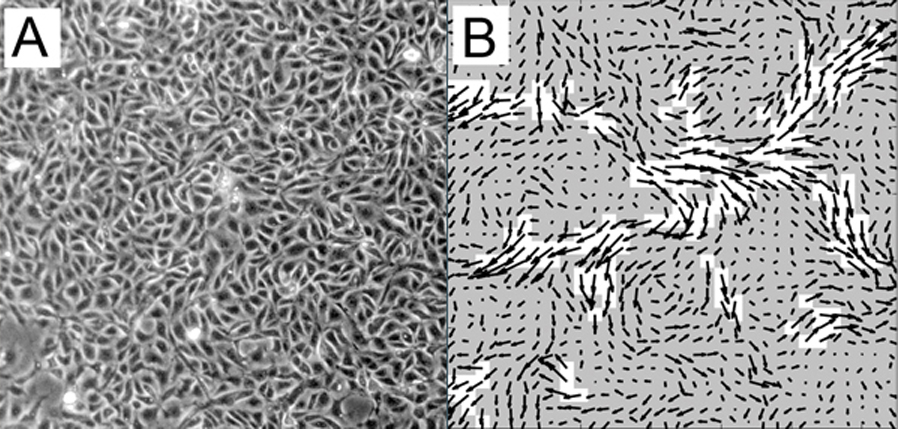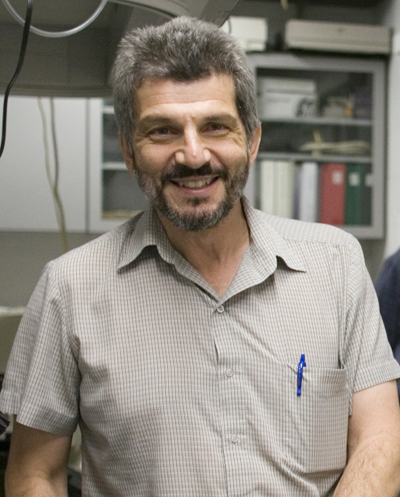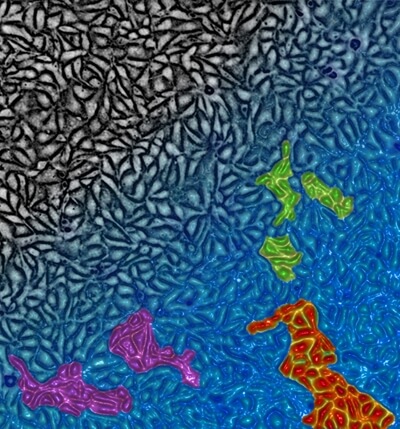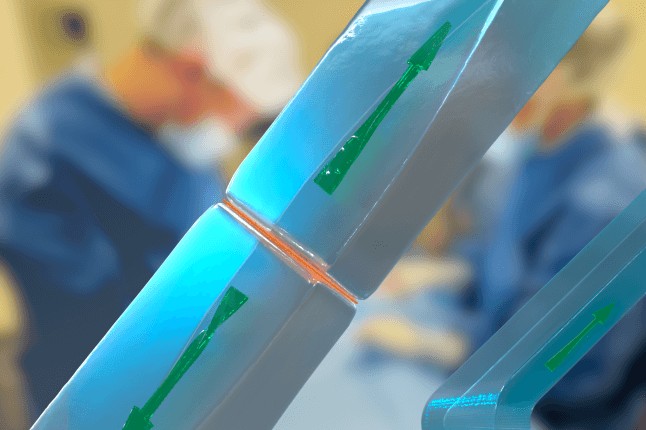News
Artist's representation of epithelial cells (black) approaching the glass transition (blue). Increasingly large groups of cells (green, purple, red) are able to move together more rapidly than the surrounding cells. (Image courtesy of Thomas E. Angelini.)

Tightly packed epithelial cells (part A) start to impede each other's motion as the tissue becomes more dense. As the collective motion slows, some cells are able to move in increasingly large groups, while others are forced to remain nearly stationary (part B). Image courtesy of Thomas E. Angelini.
Cambridge, Mass. - February 22, 2011 - By studying cellular movements at the level of both the individual cell and the collective group, applied physicists have discovered that migrating tissues flow very much like colloidal glass.
The research, led by investigators at Harvard's School of Engineering and Applied Sciences (SEAS) and the University of Florida, advances scientists' understanding of wound healing, cancer metastasis, and embryonic development.
The finding was published online February 14 in Proceedings of the National Academy of Sciences.
Cells often move from one part of the body to another. In a developing embryo, for example, cells in the three germ layers have to arrange themselves spatially so that the cells that will become skin are all on the outside. Similarly, as a cancerous tumor expands, the cells proliferate and push others aside. In wound healing, too, new cells have to move in to replace damaged tissue.
It is well known that cells accomplish these movements through internal cytoskeletal rearrangements that allow them to extend, retract, and divide. At some point during the migration, though, the new tissue settles into place and stops.
"We're trying to understand it from a fundamental point of view," says principal investigator David Weitz, Mallinckrodt Professor of Physics and Applied Physics at SEAS. "What we're really trying to get at is, why do things stop moving?"
The glass under discussion here is not the kind used in windows—though that is part of the larger category. Glasses include any amorphous materials that are viscous enough to remain solid for a reasonable period of time (often considered to be 24 hours) but which flow over longer periods (see sidebar).
Cream that is churned into butter goes through a sort of glass transition, as the increasing density of particles in the fatty emulsion forces it to become solid. Like any glass, butter will lose its form if the temperature rises.
 David Weitz, Mallinckrodt Professor of Physics and Applied Physics at SEAS.
David Weitz, Mallinckrodt Professor of Physics and Applied Physics at SEAS.
As supercooled fluids and colloids (like cream) become more dense and approach the glass transition, the particles exhibit certain characteristic motions.
"We study this extensively," says Weitz, who leads the Experimental Soft Condensed Matter Group at SEAS. "We take small particles, and we increase their concentration more and more until they stop moving and they become a glass—and we understand how that behaves very well."
Living cells, though, add several levels of complexity to the system: they vary in size, shape, and rigidity; they divide; they sense their environment; and they exert their own forces on their surroundings.
"What is really surprising to us in this research with tissues," says Weitz, "is that many of the features that inert particles exhibit as their concentration increases are also exhibited by cells. The real qualitative difference is that small particles move only because of thermal motion, whereas cells actually move themselves."
To simulate and study the migration of living tissue, Weitz's team deposited thousands of epithelial cells—specifically, canine kidney cells—onto a polyacrylamide gel containing the protein collagen. The researchers watched them grow and move under a microscope while measuring the individual and collective cellular movements, as well as the changes in density caused by proliferation.
The researchers found that when the cells are in a confluent layer (meaning that the cells are close enough to be touching), they flow like a liquid. However, when cell density increases past a certain threshold, the tightly packed cells begin to inhibit each other's movement. As a result, some cells are able to travel in groups, while others hardly get to move at all.
In other words, they behave just like a supercooled fluid or colloidal suspension transitioning into a glass.
"The implications for biological processes are very surprising," says lead author Thomas E. Angelini, formerly a postdoctoral researcher at SEAS and now an Assistant Professor at the University of Florida.
"Imagine a model wound in which a large group of cells are removed from the middle of a confluent layer," he says. "Cells will migrate inward to fill the void. Our results demonstrate that the low density of cells in the center of the wound is analogous to a raised temperature in the center of a molecular glass, causing flow within the hotter region."
"You could say that a wound is melted glass."
###
Weitz and Angelini's co-authors include Edouard Hannezo, of the Ecole Normale Superieure, in France; Xavier Trepat, of the Institut de Bioenginyeria de Catalunya, the Universitat de Barcelona, and Ciber Enfermedades Respiratorias, in Spain; Manuel Marquez, of YNano, LLC; and Jeffrey J. Fredberg, of the Harvard School of Public Health.
The research was supported by the National Science Foundation's Division of Materials Research, the Harvard Materials Research Science and Engineering Center, and the University of Malaga.
Migrating windows?

Photo courtesy of Stephanie Mitchell/Harvard News Office.
It's a common misconception that the glass in windows flows over time.
Or is it?
Look at the windows of a medieval cathedral, and you'll notice that the panes of glass are usually thicker at the bottom. Many people mistakenly assume that gravity has pulled the slow-flowing glass downward over the course of centuries.
In reality, the inconsistent thickness was just a result of the manufacturing method. Glaziers usually installed the panes with the thick edge at the bottom for the sake of stability and to prevent water leaks in the joints.
But window glass does flow. All glasses do, very slowly, but the speed depends on the molecular structure. So what will happen to the stained-glass windows of Harvard's Memorial Hall?
Not much.
In 1998, Edgar Dutra Zanotto, writing in the American Journal of Physics, used viscosity curves to calculate the length of time it would take for window glass to deform at normal temperatures.
"Window glasses may flow at ambient temperature only over incredibly long times," he concluded, "which exceed the limits of human history."
"In fact," he added, "that period is well beyond the age of the Universe."
So the windows in Memorial Hall could flow a little... but you won't notice it for at least another 10^32 years.
Topics: Bioengineering, Applied Physics
Cutting-edge science delivered direct to your inbox.
Join the Harvard SEAS mailing list.
Scientist Profiles
David A. Weitz
Mallinckrodt Professor of Physics and of Applied Physics
Press Contact
Caroline Perry




